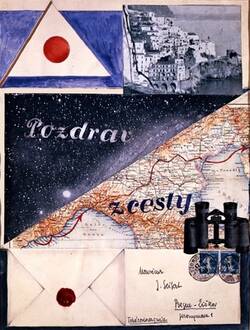Further Media
From 1919 to 1923, Teige studied history of art at Charles University in Prague. He was the most important theorist and organiser of the Devětsil association, founded in 1920. In 1924 he published the first manifesto of Poetism, in which he expressed the new generation's longing for a calm, unconstrained attitude to life and a desire for constant joy and cheerfulness, in marked contrast to the artistic mood prior to 1914, which emphasised fear and suffering. Karel Teige foresaw iconoclasm and anticipated not only the imminent demise of the hung picture and figurative sculpture, but of art in general. He believed that art would merge with life. With his critical left-wing political views, he contributed to the sharp divide between the state of art before 1914 and after 1918, which came to a head both in the public sphere and in artistic circles in the 1920s and 1930s. In this context, he refused to associate proletarian art with any educational function, as Soviet state doctrine demanded, and instead wished to devote himself entirely to the more popular forms of entertainment, such as urban folklore, the circus, pulp fiction, and film. He saw poetry as a means of expanding the human imagination and creativity, and of creating a balance between modern civilisation and human sensibility. Art should thus become an integral part of life, a joyful modus vivendi that, as Jaroslav Seifert put it, would be filled “all the beauties of the world”. In the years
1928 and 1930, Karel Teige wrote two further manifestos of Poetism, in which he developed a poetry "for all the senses" and attempted to blend Marxist cultural sociology with the psychoanalysis of Sigmund Freud.
He was interested in fine art and typography, experimented with photomontage, collage, photography, and film; he studied architectural theory and was a co-founder of the
of the Osvobozené divadlo [Liberated Theatre]. Between 1927 and 1930 he edited ReD (Revue Devětsil), the most important journal of the European avant-garde in the interwar period, and from 1929 to 1930 he lectured on the sociology of architecture and architectural aesthetics at the Bauhaus in Dessau.
In his role as a leading theorist, he collaborated with Vitězslav Nezval, Toyen, and Jindřich Štyrský in founding the Surrealist Group in Czechoslovakia (1934) and he had a significant influence on the acceptance of this cultural phenomenon in Czechoslovakia at the time.
In the late 1930s, he attacked the Stalinist regime in the Soviet Union from a left-wing perspective, denouncing its relentlessly destructive, illiberal cultural policy.
Karel Teige was one of the key figures of the European avant-garde in the period between the two world wars; as well as being an artist, he was an art theorist, critic, and publicist. Czech classical modernism would have been unthinkable without his artistic talent, his theoretical, critical, and organisational skills, as well as his personal relationships with individual artists. After the Communist coup d'état in Czechoslovakia in February 1948, he was barred from public life and denounced. He died of a heart attack in 1951, shortly before the police searched his flat, as a result of which most of his manuscripts were irretrievably lost.
His friendship with Jaroslav Seifert and Vítězslav Nezval enabled Karel Teige to adopt a radical typographic approach for their poetry collections, both for Na vlnách TSF [On the Waves of TSF] (1925) by Jaroslav Seifert and Abeceda [Alphabet] (1926) by Vítězslav Nezval, in which he unleashed a "geyser" of typographic ideas that made these works primarily a visual sensation.
The artistic practice of Teige inspired Vladimír Houdek to create the unconventional series of paintings presented in this exhibition: “The rapid pace of time in that era is unbelievable.
How much was happening all at once! That period helps me design my paintings. Collages by Karel Teige, poems by Vítězslav Nezval. Constant inspiration!” Martin Janecký was enthusiastic
about the circus and cartoons: “I have always been fascinated by the fact that people can create the most poetic things in the most hopeless of moments.”
DEPARTURE FOR KYTHERA, 1923–1924
GREETINGS FROM THE ROAD, 1924
TYPOGRAPHIC BOOK DESIGNS, 1925–1926
b. 1900 in Prague
d. 1951 in Prague
